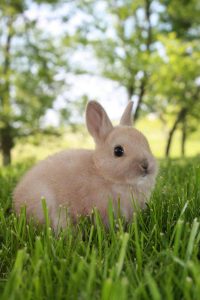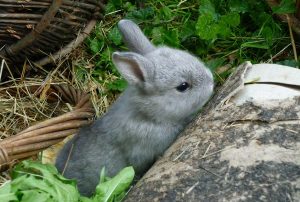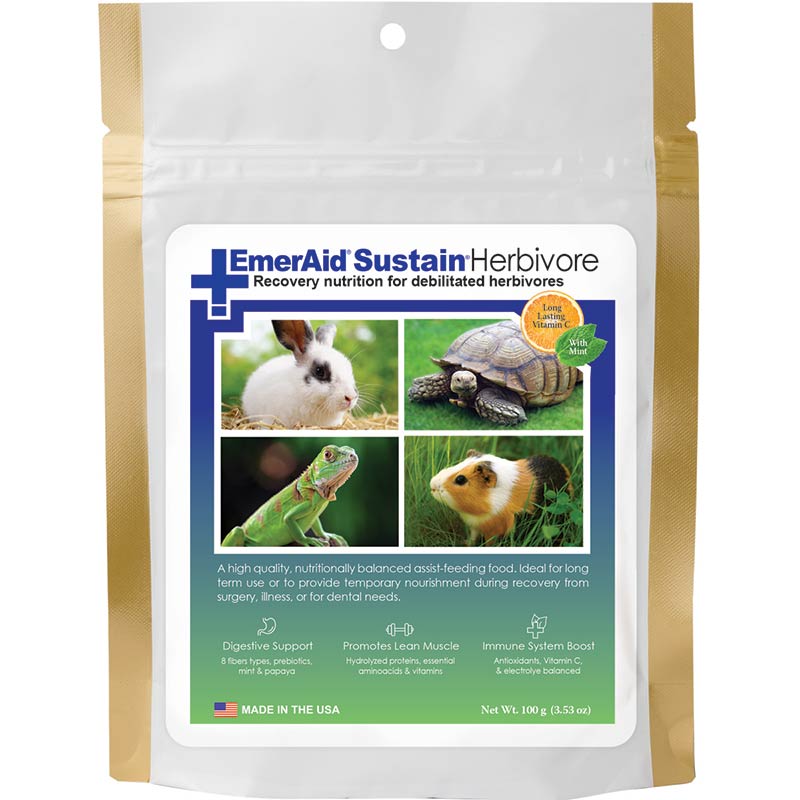
Is it a furry, compact, dynamo? No, it’s a Netherland Dwarf rabbit! Being a true dwarf breed gives Netherland Dwarf rabbits a distinct look that makes them easily recognizable. Weighing only about 2.5 pounds, the Netherland Dwarf is also one of the smallest rabbit breeds. Although their size is small, the number of colors they come in is not: Netherland Dwarf rabbits are recognized in more than 20 colors! The breed originated in The Netherlands and carries the nickname “the gem of the fancy.”
Colors: ARBA recognizes more than 20 colors in five groups.
Year Recognized By ARBA: 1969
• The breed is nicknamed “The gem of the fancy” according to the breed club in the United States
• The short face of the Netherland Dwarf makes it a brachycephalic breed.
• American Netherland Dwarf Rabbit Club
Related Breeds
Polish
Hermelin
Description

Netherland Dwarf rabbits are a true dwarf breed, which means they carry the dwarf gene. They have a compact body, large head, short face, short ears, and large eyes. It’s a distinctive look, especially the short, upright ears on the large head. The overall impression is of a young rabbit, no matter the rabbit’s age. The fur is the normal length and slowly returns to position after brushed opposite of the way it lays.
The breed standard for Netherland Dwarf calls for a short, compact body. The legs are to be short, the head round and large, and the ears short, upright, and rounded at the tip. To see some Netherland Dwarfs with good conformation, watch this YouTube video from Country Rabbit Farm that shows Best of Breed judging.
Colors
The American Rabbit Breeders Association classifies Netherland Dwarf rabbit colors into five groups: self, shaded, agouti, tan, and any other variety. Between all these groups, Netherland Dwarfs come in more than 20 colors, including black, blue, chocolate, lilac, BEW, REW, sable point, Siamese sable, Siamese smoke pearl, tortoise shell, chestnut, chinchilla, lynx, opal, squirrel, otter, sable marten, silver marten, smoke pearl marten, tans, fawn, Himalayan, orange, and steel.
History
 According to Bob D. Whitman’s book “Domestic Rabbits & Their Histories,” the Netherland Dwarf breed has its roots in the Polish and Hermelin rabbit breeds. The Polish likely originated in England or Germany and the Hermelin hailed from Germany. Breeders in Holland then worked for years on crossing this small, white rabbit with small wild rabbits and even some larger rabbit breeds to introduce more colors. They got a standard in 1940, but WWII interrupted further development. After the war, British rabbit breeder Joyce Taylor received 9 dwarfs and co-founded the Netherland Dwarf Club in England in 1949. The Netherland Dwarf first arrived in North America in 1965. Two U.S. rabbit breeders worked to get the breed recognized, and ARBA officially accepted the breed at its 1969 annual convention.
According to Bob D. Whitman’s book “Domestic Rabbits & Their Histories,” the Netherland Dwarf breed has its roots in the Polish and Hermelin rabbit breeds. The Polish likely originated in England or Germany and the Hermelin hailed from Germany. Breeders in Holland then worked for years on crossing this small, white rabbit with small wild rabbits and even some larger rabbit breeds to introduce more colors. They got a standard in 1940, but WWII interrupted further development. After the war, British rabbit breeder Joyce Taylor received 9 dwarfs and co-founded the Netherland Dwarf Club in England in 1949. The Netherland Dwarf first arrived in North America in 1965. Two U.S. rabbit breeders worked to get the breed recognized, and ARBA officially accepted the breed at its 1969 annual convention.
Personality

Use these tips when interacting with any rabbits:
- Move slowly. Sudden movements can startle rabbits.
- Learn how to properly pick up and support rabbits; they usually prefer not to be picked up.
- Try sitting on the floor and letting your rabbit approach you.
- Watch for cues from your rabbit about his or her likes or dislikes
A discussion about Netherland Dwarf personality at the Rabbits Online forum offers further insights, and another on the Binky Bunny forum also discusses Netherland Dwarf personality.
Care

Dwarf rabbits have all the basic needs of other rabbits. They need a clean, safe home, healthy food, exercise for their body and mind, and companionship. Providing a happy home for your rabbit isn’t difficult.
Choose a habitat that suits your home and rabbits, and clean it regularly. Offer plenty of clean, fresh hay and water, with a daily portion rabbit-safe vegetables and rabbit pellets. Add interest with occasional treats of rabbit-safe fruit or a rabbit-healthy treat. Keep in mind that treats should never exceed 5 to 10% of a rabbit’s daily diet.
Most rabbits appreciate having a rabbit companion, and all will enjoy free-roam time in rabbit-safe rooms of your home. Once your rabbit trusts you, experiment with games and other play activities to increase your bond.
While you regularly keep your rabbit’s habitat clean, your furry pal takes care of most of his or her own grooming. You can help by brushing daily to minimize fur mats, especially in longhaired breeds, and to reduce the risk of your rabbit suffering fur block caused by ingesting fur during self-grooming. Trimming nails regularly is another regular grooming task you can expect. Baths usually aren’t needed, unless you plan to show your rabbit. If your buddy gets dirty, try spot-cleaning rather than a full bath. When a full bath is needed, use shallow, lukewarm water; never submerge your rabbit in water.
Health
GI stasis, mites, and uterine cancer in unspayed females are among the common rabbit ailments that can occur in all rabbits, including Netherland Dwarf rabbits. Additionally, the common ailments of malocclusion and respiratory disease perhaps occur at a higher rate in Netherland Dwarfs because of the dwarf gene that gives them a smaller mouth and a shorter nose. Many factors affect the development of rabbit ailments, including environment, care, genetics, and reproductive status. But proper care minimizes some risks.
Heatstroke is an environmental concern that you can easily avoid by keeping your rabbit in cool areas. They tolerate cooler temperatures better than warmer. Humidity is also a factor, because higher humidity can make temperatures feel even warmer. According to the Merck Veterinary Manual, the ideal temperature range for rabbits is 50 to 70 degrees Fahrenheit. Thorough rabbit-proofing is another way to provide a safe environment.
A good rule to follow is to watch your Netherland Dwarf for any sudden changes. Changes in eating, drinking, sleeping, elimination, and/or activity level could signal a problem. Rabbits are prey animals and instinctively hide any weakness, such as illness, so always be alert to possible problems. Also watch for any strange discharge from eyes, ears, nose, mouth, or rear. And regularly check your pet for lumps, painful areas, or sores. This includes checking the bottom of the feet. Contact your rabbit-savvy veterinarian if you have any concerns.
On The Internet
With such natural cuteness, could fame be far behind? Not for the Netherland Dwarf. Instagram celebrities Cooper the Pooper has more than 80,000 followers, while Koji and Shiro have more than 13,000. And a YouTube video of a Netherland Dwarf named Billy Bunny has nearly 2 million views. Do you know any others?





